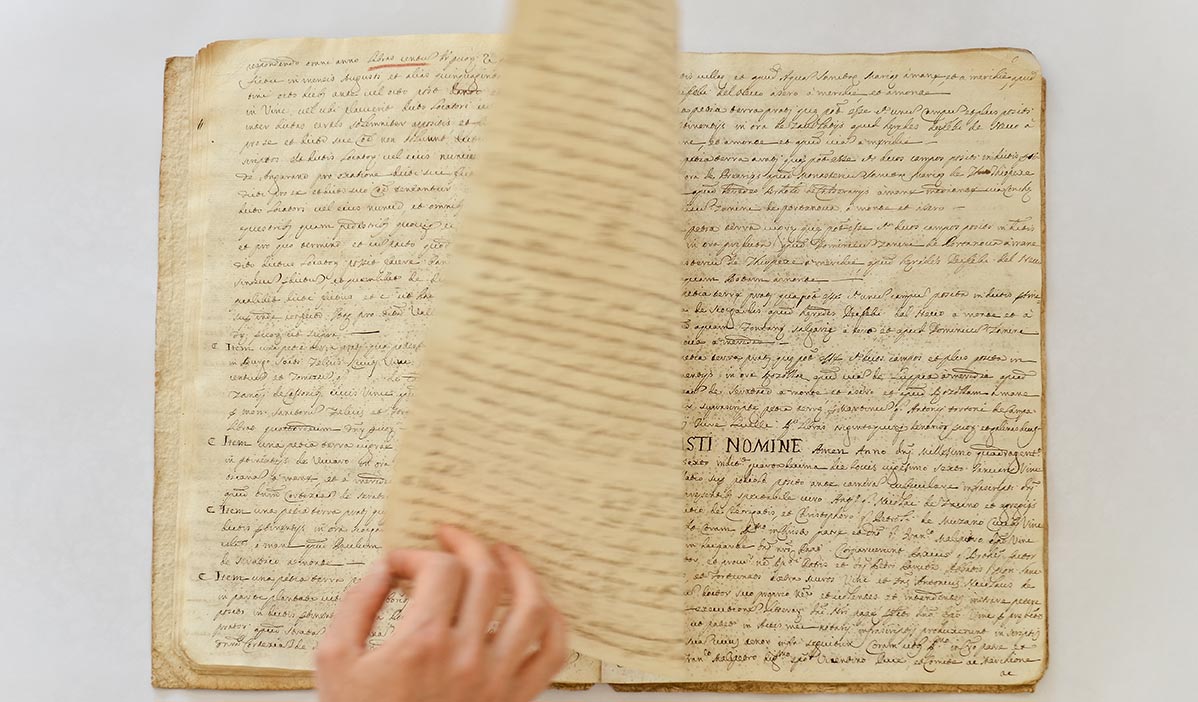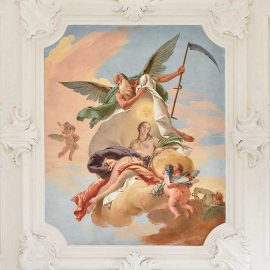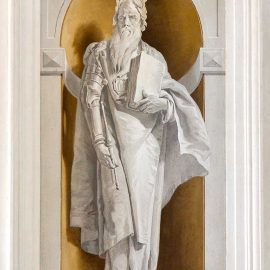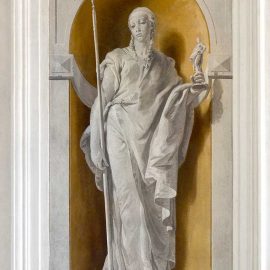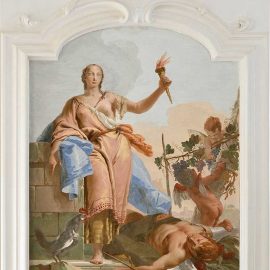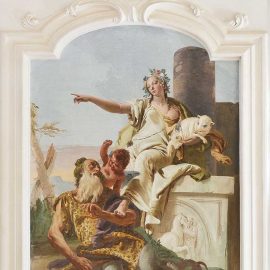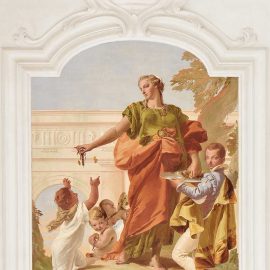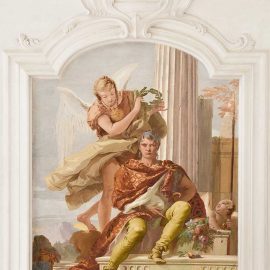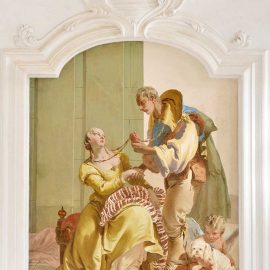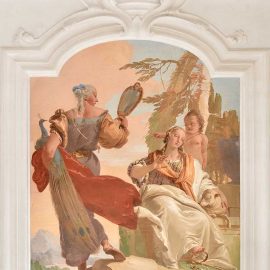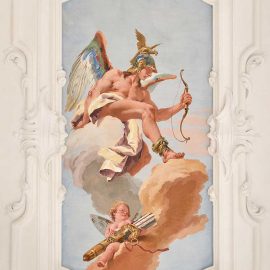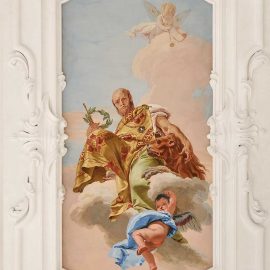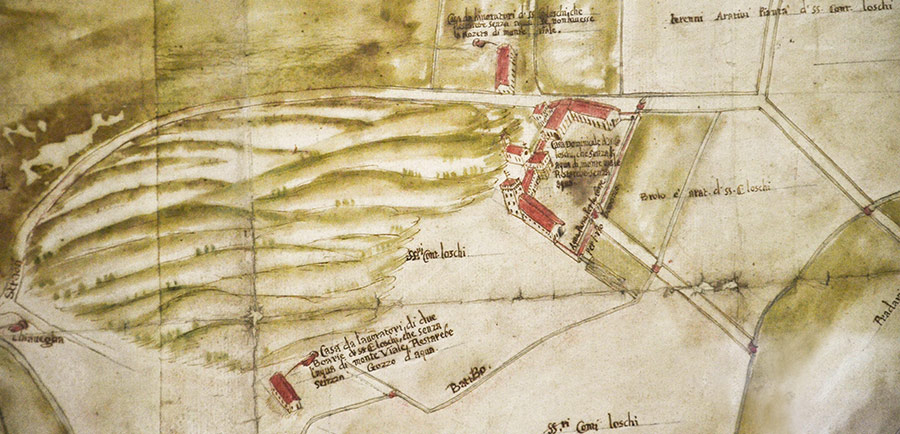
The Origins of the Villa
Imagine being at the center of Villa Zileri’s park, right in front of the main entrance of the wide and bright façade. Imagine travelling back in time, to six centuries ago, to the days before the architectural complex was first built. You would be surprised not to find the outbuilding, called barchessa in Italian, nor the manor house, nor the Loggia.
The only buildings you would see would be small and modest country houses, mainly used for storing farming equipment, and not at all adequate as a noble family’s city dwelling.
Naturally, the park, with its paths flanked by trees, gravelly trails, monumental entrance and high walls would also not exist. If we decided to leave the house, we would walk through a simple courtyard, and arrive suddenly to the edge of cropped fields, surrounded by a landscape very different to the one we see today, made of orderly fields stretching as far as you could see, with ditches along their sides and small waterways, with imperious ancient trees dotted here and there. By observing the surrounding countryside we might notice large marshy areas and forests, at the time a common feature of the plain.
In 1436, through an exchange of property, the Loschi family, one of the most powerful noble families in Vicenza since the 13th century, counts since 1426 by will of Emperor Sigismondo, came into possession of a large portion of countryside to the west of Vicenza. At that time large portions of the land, which had earlier been in the hands of the monks of San Felice, were still wild, marshy and covered in forest.
In fact, some work to reclaim the marshy areas had been made over the years preceding the purchase, thanks to Antonio Nicolò’s initiative, who, as the former tenant of the land, can be credited with the merit of seeing its enormous potential. Over the following decades, the family concentrated its efforts on its new possessions, investing resources to continue and complete the excavation of canals, as well as drying and deforesting the land, preceding by more than half a century the so called ‘care for holy agriculture’, which would characterize the noble families’ use of land from the 1500s onwards, in the Veneto region.
A long period of peace guaranteed calm and stability. Peace was interrupted only by the war of the Lega dei Cambrai (the Cambrai League), which hit the Biron property of the Loschi family. The night between the 6th and 7th of October 1513, the land of the Loschi estate became the setting of events that saw the armies of Emperor Maximilian I and of the Repubblica Serenissima (the Venetian Republic), set up camp, prepare for battle and take action, in a surprise attack, which turned into a chase and ended with the final battle of Motta, with disastrous results for the Venetians.
TORNA SU
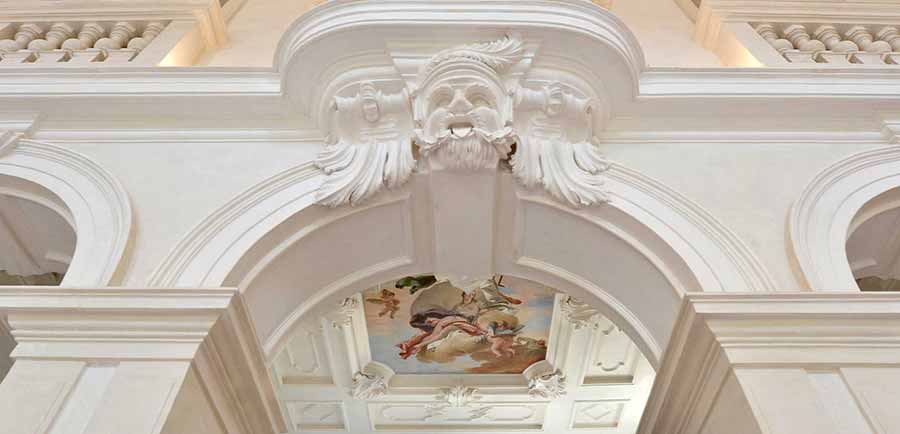
1600s and 1700s
Due to great efforts, as well as technical and organizational abilities, in the space of two centuries the land of the Loschi family was made fertile and, as a consequence, farmed so well that it became a source of exceptional wealth for the family. Alongside the growth of the agricultural enterprise, the residential complex also grew in a more or less constant way.
Let us take a look at the map made by Giovanni Briati in 1636, the most ancient visual document of the Biron property of the Loschi, today kept in the local library of the city of Vicenza, the ‘Biblioteca Bertoliana’. The vastness of the complex, along with the number and variety of buildings which make up the site, show the importance that had been reached by what had become a large and flourishing agricultural estate. At the center there is a large courtyard or quadrangle which measured over 120 meters (130 yards), closed on the east and west sides by two long barchesse, the typical outbuildings of Veneto country villas. On the south side there is a wall and on the northern side, towards San Giorgio hill, the courtyard is flanked by a series of buildings of several sizes. The manor house does not seem to tower over the other buildings, so much so that it is hard to single out. The overall complex seems to have been determined by functionality and by the concrete and practical needs of an agricultural estate, each part being added progressively over time following specific needs.
The desire to celebrate and show social prestige, which, since the fifteen hundreds, had pushed the nobles of the Veneto to commission painters and architects, the most famous of these being Palladio, does not seem to interest the Loschi family’s approach to the growth of their country estate. In the case of the Biron complex, it seems to be existing elements of the land in which it is placed that determine its orientation and shape. For example, the San Giorgio hill on the northern side, upon which it seems to sit, following its shape; the public road to the east which it coasts; and to the south the countryside towards which the estate opens up.
On the map by Briati, the chapel can be seen, placed behind the manor house, at the foot of San Giorgio hill. The chapel had been built a few years before the document was made, following directions by Elisabetta Poiana, wife of count Fabrizio, between late 1500s and early 1600s, in order to replace the older chapel, no longer in use, placed at the top of the hill.
The extraordinary grotta delle conchiglie, the cave of shells, was built in 1665 thanks to Elisabetta and Fabrizio’s son, Alfonso Loschi. This is a vaulted space with surfaces which are completely decorated and frescoed, where the noble Loschi family received and entertained their guests.
During the second half of the seventeenth century, Fabrizio who was Alfonso’s heir, promoted an intense period of restoration and extensions, applying work to the rustic annexes, even building a new stable, and a casara, a dairy farm, on the eastern side. He also built the manor houses where the various buildings that had so far been discontinuously added, were enlarged, aligned and given a homogeneous appearance. For the first time there was a desire to give prestige to the family with a new building. In the place of an old barn, which was demolished, an elegant and stately building with a grand Loggia was constructed. The Loggia had seven large bugnato arches and impressive columns of the Tuscanic order. For this project, carried out in 1692, the family commissioned Carlo Borella, one of the best known architects in Vicenza of the time.
In 1729, an extraordinary event took place in the life of the Loschi family. Finally, after many years of wait, the family became part of the aristocracy of the Repubblica Serenissima, and the addition of their name in the Libro d’Oro, the golden book of the Venitian nobility, was granted to cousins Alfonso and Niccolò. Over the centuries several members of the family had brought prestige to the family, both for literary achievements, and military feats. The humanist and diplomat Antonio, who lived between the 14th and 15th centuries, who had been chosen as secretary of three Popes and was considered very highly by his contemporaries, had been friends with other Humanists such as Leonardo Bruni, Poggio Bracciolini, Guarino Guarini and Coluccio Salutati. As for the military achievements, several Loschi members has taken part in the battles fought at the service of the king of France. Most importantly another Nicolò, who had been a personal friend of Lodovico Pico della Mirandoloa, was knighted in 1554 as a sign of gratitude for the service he had carried out. King Henry II also granted Nicolò the right to carry the three gold lilies of France on the pale blue background of the family crest. This symbol was added to the imperial eagle and the other three lilies of the original crest.
Nicolò Loschi, on the occasion of the prestigious acknowledgement received by the republic of Venice, thought it necessary to adapt the structure and the image of the Biron estate to the new social status of the family. He had the advantage of being able to count on a large economic wealth, which he had received as his inheritance.
Being a cultivated man as well as being involved in the civic life of the city of Vicenza, count Nicolò decided to use these assets to create an articulate and erudite architectural and decorative program. He turned to the architect Muttoni asking him to redesign the group of buildings as well as the quadrangle.
The architect presented a grandiose and monumental design, that included a new and vast Italian style park, with fruit orchards and fishing farms, which would be located in front of the new Palazzo, as well as a scenic staircase to reach the piano nobile, the first floor. But this design was not pursued. It underwent many changes and was largely revised in a way that altered the layout. The staircase was brought inside the building, with a first landing from which, through a doorway, it was possible to exit the building and access another staircase that led first to the hill and then all the way to a large back garden. The same landing led to a double staircase and to the piano nobile. This second idea received the approval of the commissioner and was therefore the one that was built, giving the house the appearance it has today. The stately part, with a façade similar to that of a city house, extended in its entire volume deep towards the north side and was separated from the rural annexes by a new continuous wall which separated the noble courtyard from the rural courtyard. This part became the main element within the built environment, as well as the central reference point of a new layout which now followed an ordered based on a symmetrical logic.
The design by Muttoni regarding the park remained on paper. The garden and the belvedere on the back were never made, while the park at the front was completed a few years later by the architect Giuseppe Marchi, as can be seen in a drawing preserved in the Villa.
Nicolò Loschi had the intuition to see the talent of young Gianbattista Tiepolo, at the time a rising painter, who had started to become known thanks to work in Venice, his home town, as well as in the archbishopric of Udine, in Milan and Bergamo. Nicolò employed the painter to decorate the staircase and the new hall on the first floor. In a letter written in November 1734 to his friend Ludovico Feronati, Tiepolo stated that he had worked in the countryside of Biron for three months during the Summer of that year for a commission receive a few years earlier, probably in 1729.
The architect and the painter integrated each other’s work following a well thought-out balance, creating an extraordinarily harmonious ensemble, in which the desire to celebrate the individual and the family of the commissioner are perfectly represented. The cycle of paintings, centered around the theme of Virtues, represented through the well-paced positioning of majestic allegorical figures, effectively communicates the values and achievements the family claimed to possess and that, most of all, it desired to made known to all.
With Nicolò’s learned and articulate program, the estate more or less reached its definitive shape. Later additions were minor, aimed at integrating and completing a solid and recognizable form.
The two Classical-style pavilions are designed by Ottone Claderari, who we know was also commissioned by the Loschi family to design the city Palazzo of the family in Corso Palladio, the main street of Vicenza. The pavilions are placed in front of the each other, one to the east and one to the west, and represent a connecting element between the garden and the built environment.
TORNA SU
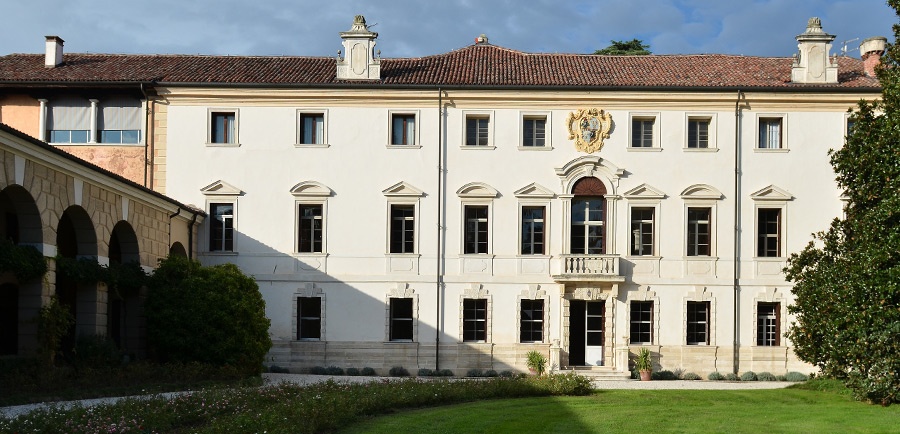
From the 1800s to the present
Throughout the XIX century the protagonist of the architectural and decorative activity in the Loschi property was Architect Antonio Caregraro Negrin. The link with Luigi Loschi and his wife Drusilla dal Verme was probably encourage by the fact they shared a patriotic sentiment and by their common engagement in the movement against the Austrian Empire.
When Luigi Loschi died in 1848, and with him the family branch ended, the Biron complex was inherited by Drusilla, who then promoted an intense program of works for which she decided she wanted to have Caregrato Negrin in charge. The extension and the new decoration of the chapel of St Francis was renewed following a lively neo-byzantine style, which clearly represents a patriotic reference to San Marco in Venice. It was probably due to Negrin that there was the intervention of one of the most important landscape architects of the time, the Milanese Balzaretti, who had been Antonio’s teacher, to redesign of the park according to the recent Romantic English style. Over all, the estate was subject to renovation and requalification both architectural, with the construction of new buildings, and agricultural, with the application of innovative farming technology, the study of which the countess herself was interested in, reaching high academic recognition.
When Drusilla died, the entire inheritance went to her nephew, Camillo Zileri, who transferred the Biron property to his son Alessandro.
Alessandro Zileri, who lived between the nineteenth and the twentieth century, was a great traveler. As a young man, between 1887 and 1889, he travelled around the world with Enrico II di Borbone, prince of Parma, as his personal secretary and friend, travelling for a few months in Asia, particularly Japan. The diary written by Zileri during those months represents a fundamental source of information to help reconstruct the events that led to the creation of an exceptional corpus of over three-thousand pieces, which were originally shipped back to Italy and collected as a personal purchase by the noble couple, and then went on to form what is now the museum of oriental art in Venice.
The inscriptions placed under the windows on the last floor of the manor house side façade, remind us of of the construction work commissioned by Alessandro at the start of the 20th century, aimed at expanding the building towards north-west, namely with the addition of a veranda at the back of the house towards the hill.
During the 20th century, and throughout the two World Wars, the Biron complex fortunately remained undamaged.
During the First World War the villa became the headquarters of the Red Cross and was, as a consequence, visited by Queen Margherita. During the Second World War, from 1943 to 1945, the buildings were occupied and became the seat of the command of the Todt division. Those who occupied the villa, however, kept a respectful attitude towards the house and in particular the Salone d’Onore with Tiepolo’s frescoes, which remained untouched by these historical events.
The property remained in the hands of the Zileri counts until 1974, which is the year in which the villa was bought by the company Montecastello SpA, the current owner.
In the following decades the buildings were subject to systematic renovation and restoration works, aimed towards conservation and requalification for a contemporary use of its spaces. The manor house and the rural annexes are today given corporate and residential use.
From 2012 to 2013 Motescastello spA promoted the restoration of the Salone d’Onore, which included the whole decorative system, and consisted in cleaning the marmorino walls and the stucco decoration, using a predominantly conservational approach on Tiepolo’s frescoes.
TORNA SU
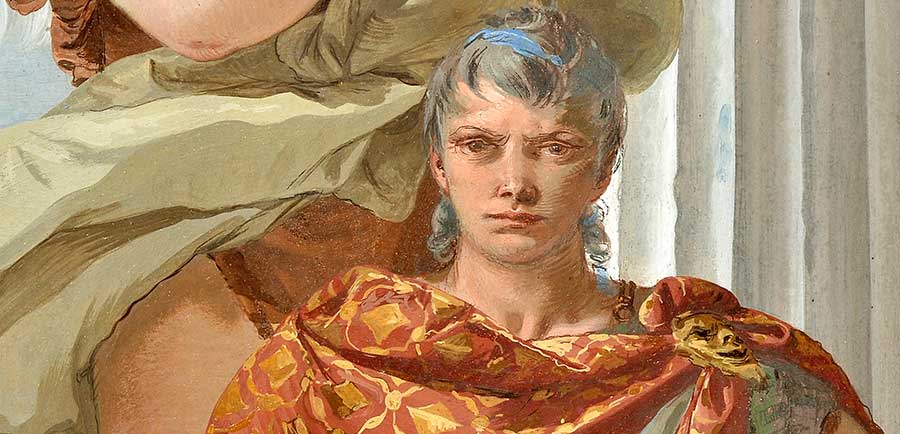
The Salone d’Onore and the frescoes by Giambattista Tiepolo
When, in 1729, count Nicolò Loschi obtained the prestigious inscription in the Libro d’Oro, the golden book of Venetian nobility, he immediately set about to renew the Biron family estate..
For centuries, since the purchase of the rural area west of Vicenza by his ancestor Antonio Nicolò, the court yard and the buildings around it had remained nothing but the home of the flourishing farm. It was certainly a large and articulate complex, but decidedly too rustic and inadequate for the social life and image of a gentleman of his status. The only exceptions were the Grotta delle Conchiglie, the cave of shells, built during the mid 17th century, which was by then out of fashion and too small to host his guests, and the impressive Loggia, built by his uncle Fabrizio only fifty years earlier, which certainly had a scenic quality, but which was an isolated piece of architecture, not entirely integrated with the rest of the buildings. His ideas pointed in an entirely different direction. He wanted to make this country dwelling worthy of the prestige brought by the new social status, both his and of the family name. This would require a radical transformation, both of the manor house and of the outdoor areas, which would finally host a garden for entertaining visitors and not just the farmyard and orchards.
To give his ideas form, Nicolò decided to turn to one of the most popular architects among the noble families of Vicenza of the time: Francesco Muttoni. The architect enthusiastically reinterpreted the commissioner’s desire for self-celebration and presented him with a design which was grandiose in size, with a vast Italian style garden in front of the villa, with enormous pools and fish farms. This kind of design would be able to compete not only with the houses of other nobles of the Venitian Republic, but also with the courts of the sovereigns of Europe. The design was also revolutionary in its layout, with a spectacular external staircase to access the salone nobile, an important room which was as deep as the whole building. A drawing, signed and which can be dated 1729, shows the details of the solution at this first stage. However, evidently this was too much, excessively ambitious even for the noble Nicolò, who indeed belonged to the Loschi family, who had been intelligent and cautious entrepreneurs for centuries. Nicolò must have taken into account the enormous waste, for solely esthetic purposes, of an extremely precious resource which at the time was water, as well as of course the cost of the whole endeavour. Or at least this is what we can infer, since today there are no documents about the matter, except another drawing by Muttoni which shows the new solution he proposed, with the staircase inside the building and the idea of three large arches placed as a diaphragm to connect the salone nobile. This is the layout the building has today, and must therefore have been approved of by the owner of the house.
To create the decorative cycle Nicolo Loschi turned to Gianbattista Tiepolo. We can obtain important information about the assignment for the Biron house, directly from the words of Tiepolo himself. In November 1734, he wrote a letter to a friend, Lodovico Ferronati, to this day preserved in the library of the Museum of Bergamo, in which the artist justifies his delay in answering the request of a new commission with these words:
[…] e se non fossi stato mesi tre in Vicenza per un forte impegno, che da molti anni avevo che per destrigarmi ò dipinto si può dire giorno e notte senza respiro […].
[…] and if I hadn’t been for three months in Vicenza for an important engagement, that I had had pending for many years and to free myself of this I can say I painted endlessly (litt. without breathing) day and night […].
Tiepolo seems to confirm that 1734 was the year of execution of the frescoes, by declaring he was busy doing difficult work for three months during the Summer of 1734, the same year that appears in the inscription placed on the southern wall of the salone nobile. The clarification regarding the important engagement, that ‘had been pending for many years’, makes us think that the first contact between the artist and the commissioner had taken place some years before, and this was probably in 1729, at the same time as Nicolò had contacted the architect. With the word destrigarmi (‘to free myself of this’) the painter unwittingly reveals to us that plausibly the relationship with the commissioner was not all that easy. As the events linked to the special design of the estate confirm, due to changes of opinion and new prompts coming from the commissioner, it had taken a long time to define the general layout of the architectural space and therefore even the design of the decorative cycle. In contrast to these prolonged times we see the rapid execution by Tiepolo, due partly to the impatience of both count Nicolò and the painter who, for different reasons, wished to finish the work as soon as possible (ò dipinto si può dire giorno e notte senza respiro).
The speed at which the frescoes were painted, which can be seen in the precise brush strokes, was made possible thanks to the mastery that the painter had acquired by that time, a technical skill and a full mastery of expressive media which would characterize his work throughout his career. In 1729, when he was chosen by count Loschi, Tiepolo was still a young painter, albeit with a great talent, a painter who had already given proof of his skills by carrying out important tasks such as work for the archbishopric of Udine, the Venitian noble Dolfin, and the Colleoni Chapel in the Duomo of Bergamo city. By the time he painted the frescoes in the Biron villa, he had reached full artistic maturity. The Biron cycle has the fortunate condition of having been executed by the master when he reached full artistic mastery, but also in a historical period when he did not yet have his two sons, Giandomenico and Lorenzo, working at his side, nor the rich team of workshop artists that would later accompany him during the rest of his career. Therefore, it can be said that each brush stroke was painted by the hand of Giambattista Tiepolo himself..
The frescoes have reached the present day in good condition, primarily thanks to the high quality materials that were used, and secondly due to the care and attention they received over time from the owners of the house. Finally, also the fact the Salone, as the whole villa, lived through historical events without great traumas, even the most xx ones such as the two world wars. Due to this specific coincidence of circumstance the frescoes of villa Zileri are considered one of the best resources to help us study Tiepolo’s painting technique.
The salone d’onore was the place where guests were received, the place where parties were held, which served to build a public image of the family. For this room, Nicolò Loschi, a man to whom even his contemporaries recognized a vast humanistic culture, engaged in civic life with several civic roles as was expected of a man of his status, designed an iconographic story centered around the virtues that he and his family proudly claimed to possess, while being presented as an example to follow.
Tiepolo was asked to give form to the ideas of the commissioner, painting within specific spaces, outlined by stucco frames. To do this he followed a general decorative plan of the whole room, which had been decided by the architect Muttoni, the oldest of the two artists working in Biron. The solution Tiepolo came up with was to represent the abstract virtues with an allegorical use of human figures, pictured interacting with each other. As we walk up the first part of the staircase and stop on the landing, to our right and our left we are greeted by two monochrome statues , Merit and Nobility, representing the key elements of the entire cycle. On the walls along the staircase and of the salone, each fresco is dedicated to impressive figures standing in solemn and emphatic poses, while dominating the space, and placed as if they were characters on a stage. On the staircase we can admire Innocence and Vigilance standing opposite to Deceit and Slumber, and in the salone we find Freedom bearing gifts and Marital Fidelity. On the ceiling of the main hall we see Triumph of Glory announced by Fame standing among the Cardinal Virtues, where Tiepolo proves to have a great grasp of the complex composition or birds eye views with many of the figures portrayed sideways and moving in spaces which appear spacious and filled with light. It brings a smile on the visitors face that such an impressive parade of virtues is paradoxically placed next to a fresco dedicated to Modesty, who with a humble gesture tries to send seductive Pride away!
The human figures and the visual stage created by Tiepolo are placed harmoniously within the architectural context and in the rooms created by Francesco Muttoni, creating a bright ensemble that impresses and draws the visitor in, while being is progressively led to admire, read and ponder upon its content, consequently fulfilling what Nicolò had requested and hoped for.
TORNA SU
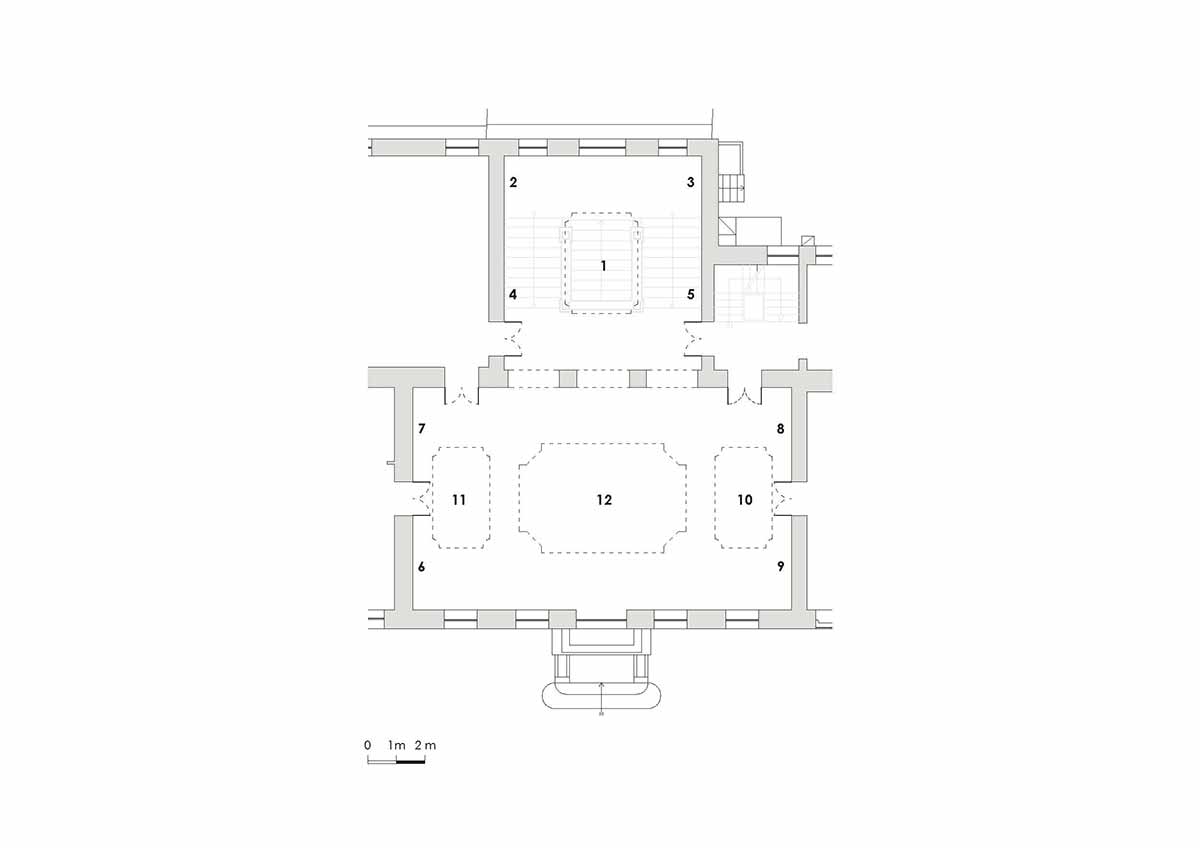
gli affreschi
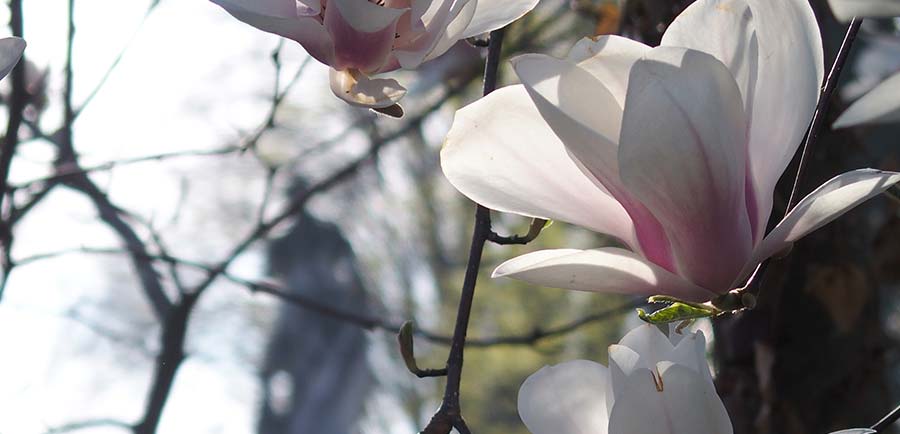
The history of the Park of Villa Zileri
Villa Zileri’s historic park, which surrounds the manor house and the rural annexes, has been preserved intact and has the good fortune of being placed at the center of a vast countryside, where more or less no recent residential or industrial buildings of significance have been built, and which gives the park great historical and environmental value.
The green area around the villa can be considered a ‘park’ starting from the time when the Loschi family felt the need to use their country dwelling as a tool to promote the social image of their family, which happened at the start of the 18th Century with Count Nicolò. At the time, the property of the Loschi family extended around a large area. On the east side it nearly spread all the way to the city doors of Vicenza, to the west it reached the foot of the Monteviale hills, southwards it touched the area known as Ponte Alto and northwards it reached the area of the Maddalene, following more or less the border between the two villages of Monteviale and Costabissara.
Since the beginning of the 17th Century, as the various historical maps confirm, consistently with the exclusively productive nature of the Biron property, the rural court yard had only looked towards an agricultural landscape of farmed fields. In the design presented by the architect Muttoni, presumably in 1729, the new suggestions regarding the building and the area in front and behind the villa are given equal attention. Clearly the owner had felt the need to fill a void in the family property, and had received enthusiastic response on behalf of the architect, who designed a great and prestigious park, which can be considered a fundamental element filled of subtle meaning. The enormous areas used as a fruit orchards, the large flower beds and the enormous fish farms would have been an eloquent introduction for all visitors reaching the property, even before they reached the villa itself. At the back of the house, upon a plateau created on the san Giorgio hill, there would be an Italian style belvedere surrounded by walls which would have become a continuation of the salone nobile.
The impressive ideas of Muttoni were not all well received by the owner, neither in relation to the building nor the park. As far as the garden is concerned, several years later, following a design by Architect Giuseppe Marchi made in 1736, a simpler and more practical solution was chosen, made out of large square flower beds, separated by small pathways, and only one rectangular fish farm.
During the mid 19th century, as cultural tendencies and aesthetics concerning parks and country houses changed, at villa Zileri the need was felt to adapt the set up of the park according to the new romantic taste of the English garden. At the time the owner of the house was Countess Drusilla Dal Verme Loschi, wife of Luigi, the last of the Loschi family, whose death in 1848 had ended the family line. Drusilla was an enterprising woman, involved in the farms agricultural activities, her entrepreneurial attitude meeting her love for research and innovation. Partly because of a shared patriotic sentiment, she was friends with Architect Antonio Caregraro Negrin, towards whom she turned to redesign the chapel of the San Francesco palace as well as the park. The design included the area in front of the manor house as well as the part at the back, which had not yet been landscaped, but also the entire San Giorgio hill, which had so far been covered with farmed land, as well as the entire land of the estate. Given the complexity of the commission, the vastness of the area and the importance of the commissioner, the need was felt to ask for the expertise of one of the greatest landscaping experts of the time, the Milanese architect Balzaretti, who had been Caregraro Negrin’s teacher.
To this day, there is a map drawn by Balzaretti, in which a new layout for the park is outlined, and which show a complete change compared to previous ideas. The new layout abandons an axial and symmetric logic, by placing the main entrance to the west, to create a direct connection with a new road junction around which all the roads leading from the villa would be organized, giving great importance to those leading to the city of Vicenza, which had so far been neglected. The path would continue into the garden both level with the house and up the hill, in a winding way, with pathways, lines defining the meadows, small wood areas and groups of trees, all enriched by waterways. The park would open outwards, continuing virtually towards the countryside, where the presence of ancient trees, placed following specific perspectives and view points, would give the impression the park continued all the way to the foot of the nearby Colli Berici.
Those who found themselves walking around the garden would have felt guided in an experience along a series of exciting yet perfectly natural scenes, discovering new ones at each turn, while feeling surprised to be admiring exotic plants and rare combinations of colours.
The design was welcomed by the owner, even though, as with the works of the previous century, the commissioner downscaled the grandiosity of the layout and shifted it towards a more practical and spatially contained one. For instance, the transformation of the entire San Giorgio hill was not carried out completely, although non-local trees were planted. The road system was only partly modified. However, the appearance the park has today and its layout derive mainly from the work which Countess Drusilla and Caregraro Negrin carried out following the guide lines of Balzaretti. The movable greenhouse, designed by Caregraro Negrin with the idea of it being used near the main entrance, was born from the Countess’s interest in botanical and experimental agriculture.
When Drusilla Dal Verme Loschi died, the Biron property was inherited by count Camillo Zileri, her nephew. The son of the latter, Alessandro Zileri was a keen traveler who as a young man travelled to many exotic places, starting from the journey that between 1887 and 1889 led him round the world next to the Henry II of Borbone, prince of Parma, on which occasion he stayed for a few months in Indonesia, China and Japan. During this and the following travels, count Alessandro came into direct contact with the cultural wealth of the oriental garden, which was already popular in Europe. He must have been fascinated by it and most probably returned to his country full of ideas that he could apply to the estate of Biron and maybe even with exotic and rare plants that he could add to the park.
TORNA SU
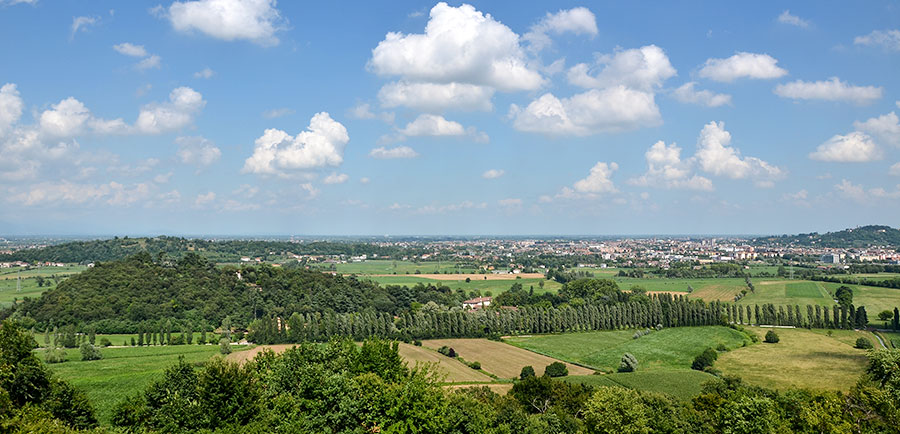
Environmental and Natural Value
The park of Villa Zileri and the countryside around it correspond more or less to the original size of the estate of the villa, and are of high environmental value, which is all the more relevant if we consider how close the area is to the urban center of Vicenza, only a few kilometers away.
Unfortunately, this is a rare condition in the Veneto plain, and it is thanks to a certain historical good fortune that the rural environment has remained intact and for a large part free of urban elements. This part of the territory represents a precious historical document, as it preserves a historical agricultural set up, and allows a clear understanding of the various stages that have progressively and over time given it the appearance it has today.
Thanks to the various works which were designed and carried out in a planned and ordered way, the area of the park is today a unit of great interest from a botanical point of view. There are several examples of veteran trees, that stand out either due to their age, the circumference of the trunk, the height of the tree or the size of the crown. Among these, there are some worth mentioning: a taxodium with a trunk of 7 meters and a crown which reaches 30 meters, a sycamore with a trunk of 5.5 meters and a crown of 40 meters, a pathway of white hornbeams among which one tree stands out, with its trunk as thick as 5 meters. In the whole countryside, which once was part of the estate, the landscape is characterized by numerous examples of monumental trees, that are proof of the romantic set up of the 1800s. Both in the park, in some of its flat areas and in the woods, as well as in the surrounding land, especially along the agricultural system of canals, there is an interesting variety of species of flowers and herbs, some of which are particularly important due to their rarity or as clues towards a better understanding of the natural environment of the past.
As for the fauna is concerned, the area of the park and the countryside around it, in the flat areas as well as in the hills covered in woodland, are an oasis in which many wild species, find the perfect habitat, among which even some rare species that can be seen in the plains just a few kilometers from the city of Vicenza.
Due to the great quantity of water in the area, this is a place where wader birds live all year round, such as white herons, grey herons and egrets. Along the canals, common moorhens nest, as well as passing wild ducks. It is not uncommon to be able to see roe deer cross the fields when moving from one hill to another. On the San Giorgio hill there are also small mammals such as foxes, badgers, weasels, dormice, and some predatory birds, such as owls, barn owls, and kestrels. The variety of avifauna is very rich and includes a number of migratory species that use the land both as a stopover and to make their nests, which is a sign of the particularly favourable environmental conditions of the area.
TORNA SU
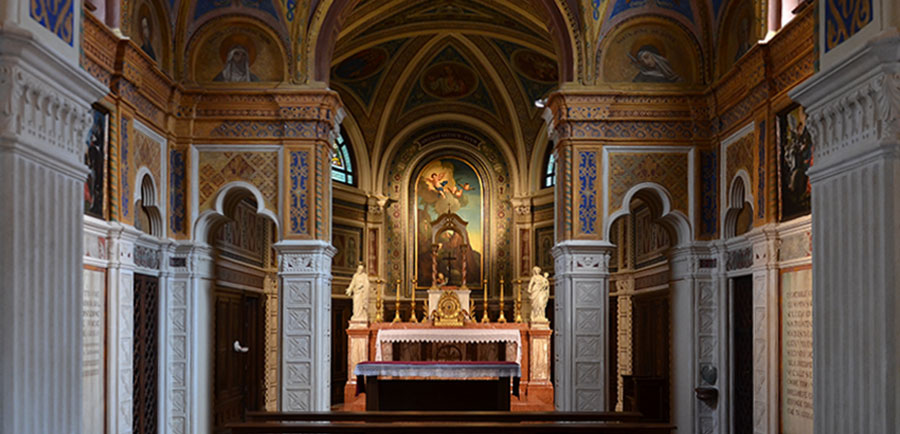
The wonders of Villa Zileri – San Francesco chapel
Desidero poi, che sia eseguita la pia volontà della Illustrissima Signora Isabetta mia moglie, la quale con ogni spirito procurò e fece edificare una nostra Chiesa attaccata alla Casa Dominicale di Biron intitolata San Francesco, con pensiero d’adottarla, et eleggere un sacerdote […].
I also desire that the pious wish of the Illustrious Lady Isabetta, my wife, is carried out, she who with all her soul made it possible to build one of our churches next to the Dominican house of Biron, dedicated to St Fancis, with the idea of adopting it, and electing a priest […]
From the words of Fabrizio Loschiwritten on the 11th of May 1617 in his will, we discover that it wasthanks to the initiative of Elisabetta Poiana that the chapel of Villa Zileri was built.
The building we can admire today is different in size and in decoration to the one of the 1600s, because over the centuries a change of taste and practical needs caused an evolution of spaces and decorative form.
We can get an idea of how the chapel looked like, when Elisabetta and Fabrizio entered it to pray, by looking at some historical documents. In the map of the properties of the counts, made by the surveyor Giovanni Briati in 1636, there is a holy building, that looks like a small church. It is placed at the foot of the San Giorgio hill behind the manor house, slightly separate from the rest of the building, which is the chapel’s current position. The church can be accessed from the garden. In fact, for some decades, the entrance from the public road was its only access, and it was used by the inhabitants of the earldom as a reference point for the religious life of the community.
During the following century, in 1729, architect Muttoni designed a complete reorganization of the complex, commissioned by Nicolò Loschi. The drawing shows the plan of the building, which is more or less square and connected to another room of a similar shape and size, which is in turn connected to the rooms of the first floor and to the Loggia. Even the apse was square, while the main room was filled with the light coming from two windows on the walls, on the east and west sides.
The church we enter today has a different plan, still with one single room, but with a rectangular shape and characterized by the presence of four pillars and by a deeper apse. How was this new look achieved?
During the 18oos, another female figure was the protagonist of the first important changes. Countess Drusilla Dal Verme, wife of Luigi Loschi, around the mid-1800s, appointed architect Caregraro Negrin to redesign the rooms and the decorative system.
This initiative should be seen as part of a broader reassessment of the Biron property, wanted by an intelligent and learned noble woman, who was active in the political life of her time. Lady Drusilla was so close to the movement of the Risorgimento that she was painted in 1876, by the painter Perlin, next to the city authorities and the protagonists of the Risorgimento of Vicenza, in a famous painting that celebrated the delivery of the gold medal to the city by king Vittorio Emanuele II, which is today in the Museum of the Risorgimento and Resistance of Vicenza. Furthermore, Drusilla was at the forefront in the study of agronomy and in applying innovative techniques to the fields of her family property.
Caregaro Negrin joined the space next to the holy building to the main room of the chapel, doubling the surface occupied by the church and giving it the size it has today. The plan remained with one room, but where there was a wall two pillars were placed, made in pietra di Vicenza, the local stone. Towards the wall at the back, a platform was created with a low and arched ceiling, separated from the main space by a kneeling stool made of carved wood. This space would serve as a private area from which the noble family could attend mass. The decorative design was covered by the elements of the vault and, on the upper level of the walls, by figures of saints, both male and female, and evangelists, painted upon a golden yellow background. The presence of rich geometrical polychrome patterns, placed on neo-gothic reliefs and surfaces, contrasts with the appearance of lower level which is characterized by the white of the stone pillars and by large rectangles with holy inscriptions. This design was born from a mixture of eclectic taste of the time and from a deliberate hint towards Christian byzantine art, as well as the mosaic art of the time. Behind the altar there was a large altarpiece depicting the ecstasy of St Francis. The exterior of the church was characterized by a horizontal pattern created by alternating white and red brick, which is the way the building appears today.
During the first half of the 20th century, the owners decided to further modify the Biron chapel. Countess Bartolini Carega Zileri had the apse enlarged and covered by a wooden panel decorated with trompe l’oeil engravings. She also wanted to radically renew the painted areas, even though only a few decades had passed since the previous works. An inscription shows the name of Tito Chini and the date 1940.
The cheerful motifs of Caregaro Negrin were covered by a new layer of geometric patterns, which covered the whole surface, leaving the stucco framework clear. The figures of the saints on the ceiling and walls were left untouched, and these were chosen as the characterizing motif of the ceiling of the new apse, with images of the female saints and Christ enclosed within medallions. At the lower level the white Vicenza stone was covered with a layer of colour, while the rectangles with the inscriptions were kept, albeit with some variations in the text. To complete the walls there were four paintings on canvas, depicting scenes of The Passion, probably moved from a previous location, maybe within the chapel itself. The countess also asked Tito Chini to decorate the half moons on the glass panes in the apse with her own family Crest, Bartolini Carega, as well as her husband’s, the Zileri crest.
This is the way the church presented itself up to 2007. In that year, on the occasion of some maintenance and reparation work on the glass panes of the main hall, thanks to a survey carried out with tests on the walls, to everyone’s surprise, the presence of a second layer of paint was discovered beneath the final layer. Soon it was clear that the drawing signed by Caregaro Negrin was still there and was rather well preserved.
With the approval of the local supervising authority, a series of restoration works began, with the aim of recovering the 19th century appearance of the chapel, so as to restore an exceptional example of religious architecture designed by Caregaro Negrin. The works, which continued for two years, until 2009, radically improved the building, and included extraordinary maintenance on the floors, the wood furniture, the marble parapet of the altar, the restoration and consolidation of all the glass decoration of the lunettes, particularly the two crests, that were in critical conditions, and finally cleaning the four paintings and the altarpiece.
TORNA SU
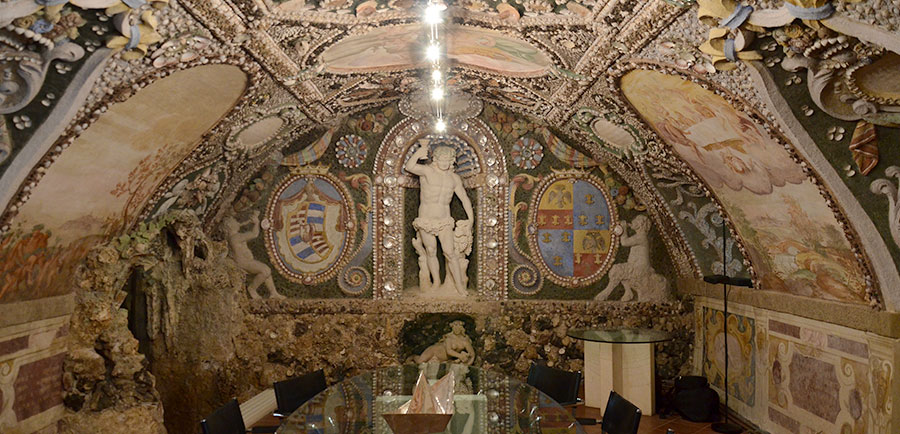
The wonders of Villa Zileri – La Grotta delle Conchiglie, the cave of shells
During the mid 1600s the complex of Villa Zileri still looked like a rural estate, consisting in a group of buildings destined to practical needs, and lined next to each other around a large courtyard.
Alfonso Loschi,at the time the head of the family and owner of the estate, felt the urge to create a new representative space next to the manor buildings, destined to receive and impress guests and visitors. This space was the grotta delle conchiglie, the cave of the shells, a vaulted space partly excavated into the rock of San Giorgio hill, in which all surfaces, except the floor, are completely decorated.
The walls and the ceiling are covered in shells that create geometrical and floral motifs, outlining frames and creating fantastic figures with monstrous faces, made more precious by tortoise shells, coloured crystal balls and coral, intertwined with colourful reliefs made of plaster, creating a continuous decorative scheme.
Cornici di conchiglie circondano anche ampie specchiature, nelle quali sono raffigurati con pittura ad affresco episodi della mitologia classica.
A framework made of shells surrounds the large spaces within which episodes of classical mythology are represented with paint and fresco technique.
The overall impression is to be within a unreal environment, suspended in a world where the sea meets nature’s flourishing and abundant exuberance.
This sort of creation was common in the noble dwellings starting from the 1500s, a century when the culture of the renaissance rediscovered a fashion which was typical of the classical world, when the country villas of the roman patricians were embellished by artificial pools surrounded by statues of nymphs or even proper caves, both natural and artificial. Already in classical times, shells, fossils, and water games were the setting for statues of divinities and nymphs, who were originally venerated as protectors of water sources. In the 1600s the impressive spaces of caves were particularly popular, as they met the baroque taste for surprise, marvel and exuberance. They became richer in decorative elements, and a pretext to show rare and precious natural objects, sometimes coming from faraway and exotic lands. As well as being a place of leisure for the owner of the house, they also became a place for observation and study for those who were interested in the subject, making these spaces similar to the concept of a wunderkammer
In the case of villa Zileri, the cave of shells also has a representative role, unlike previous examples of similar buildings, as the family used the space to show its riches and prestige before their guests, underlining the special wealth of the Biron estate.
The main themes through which we should interpret the decoration and the frescoes of the cave, are those of fertility of the soil, with a particular reference to vine farms, and water. The latter was abundant in the countryside surrounding the villa, thanks to sources near the foot of the hills and in the plain, where water works had been carried out in the 1400s, canals had been built and water used as a source of wealth both for farming and for watermills. Inside the cave itself, we have access to a natural cavity in the rock of the hill where once there was a real water source, and from which to this day, during some time of the year, water gushes out. About vine farming and the production of good quality wine in the Loschi estate of Biron, this is what the historian father Gaetano Maccà wrote: Monteviale is four miles from Vicenza, and about five miles from Montecchio Maggiore. It consists in a mount, several hills and smaller hills and a plain. [… ] Its countryside is very fertile. The hills and the mount itself are covered in vine farms, and good quality grape vines are abundant, used to make delicious wines. (1814, p.156).
The description of the fertile countryside surrounding the villa and the tale of its riches are told in a visual way through the fescoes on the walls and the ceiling, in which we see a celebration of classical divinities and nymphs, a typical presence in similar caves. Two of these paintings, all of which are painted by a skilled artist, although attribution is uncertain, refer directly to the god Baccus. In one painting he is represented as a vigorous youth who is busy admiring the beautiful Arianna, while she dances, and in another painting he is depicted as an older man, with an opulent figure, being carried by love figures, who are celebrating and raising glasses filled with wine. A large statue of the god Baccus, placed in a niche on the wall opposite the mail entrance, stands welcoming the visitors and beckoning them with a subtle smile, a cup of wine raised for a toast. Beneath, half lying in a smaller niche, there lies a female figure dreaming, most likely identifiable with Arianna abandoned on the island of Naxos. The other two frescoes have as a protagonist thoughtless Hebe, goddess of youth, who falls from the clouds where a banquet with the gods of the Olympus is taking place, and plummets to the ground towards a flourishing rural land. The other is the figure of Actaeon in the moment when his metamorphosis into a stag has already started, his punishment for having seen Diana and her nymphs bathing at the source. Poetical verses are painted within the frames and comment each scene. Raising our eyes to the ceiling we see Venus accompanied by Cupid on one side, and Ceres on the other, her head crowned with a wreath of wheat stalks.
Clearly these motifs are interlinked. Water, vines and wine, youth, all work together to exalt and celebrate the themes of life and fertility, that find in the fertile countryside of Biron a concrete and tangible example. For count Alfonso the cave was an occasion to show the riches of his estate and of his family as well as a place to invite his guests to enjoy and share the abundant fruits of this fertile land.
The inscription placed above the main entrance: “Alfonso Loschi, made 1665, Drusilla Dal Verme […] restored 1865”, reminds us of the year the cave was built and about the first restoration works, carried out in the 1800s, thanks to countess Drusilla, who put a lot of effort in the Biron estate, and also commissioned architect Caregraro Negrin to redesign the St Frances chapel, as well as to redesign the park according to the new Romantic English taste. To each side of the statue of Baccus, two great family crests remind us of the coat of arms of the two families, the Loschi and the Dal Verme.
A second restoration project, finished in 2012, made it possible to restore the original brightness of colour or the decoration, thanks to a careful work to consolidate and clean the entire surface of the hall, removing the opaque coating that had formed as a deposit on the surface of the paintings and addressing the damage caused by rising damp.
TORNA SU
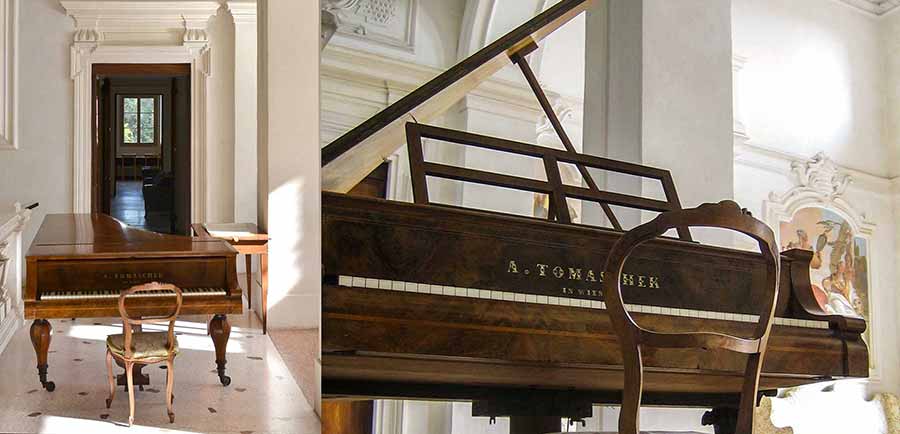
The wonders of Villa Zileri – The fortepiano
Built between 1845 and 1850, the fortepiano of Villa Zileri is a magnificent example of the mastery of the famous and prestigious Viennese company, ANTON TOMASCHEK.
Some technical information: the keyboard’s range is of 7 octaves, the essence used for the structure is high quality national walnut, the total length is 2.40 m. The high notes and the center are placed on a bridge made of maple and each note has a triad of iron chords, while the low notes have a separate bridge and the notes, made of iron and covered in brass, have a part with two chords and a part, the final one, with one chord. There is an iron separator and, in the upper part, a pair of supporting bars also made of iron.
The mechanics of the piano are typically Viennese, with the hammers covered with three layers of sheep skin plus an outer layer of chamois. The diatonic keys are made of ivory, the chromatic of ebony.
The instrument has two pedals: the one on the left activates a chord that moves the keyboard to the right, enabling the hammer to hit two chords instead of three, the second one lifts the bar of the damper, enabling the chords to vibrate freely.
In 2008 the instrument underwent a series of conservation and restoration works, carried out by the maestro Giuseppe Tolin, a great expert in instruments and in particular in the fortepiano, who is a reference point for various museums and foundations in matters of maintenance and conservation.
The works were preceded by an analysis of the general conditions of the fortepiano, from which it became apparent that, fortunately, the instrument was in good condition. The fortepiano underwent a mechanical check up and an assessment of the keyboard. Afterwards it was cleaned, and finally it received a woodworm treatment for the wooden parts. It was also necessary to substitute part of the connections of the pedals and some of the chords, which were replaced with ones made according to the original tradition of the 19th century. After this phase of restoration it was possible to tune the instrument, using a series of Diapasons 440. For the piano to reach a suitable level of acoustics, it was necessary to carry out 6 tuning sessions over a period of two months.
TORNA SU
INFORMATIONS AND CONTACTS
Opening times:
From Monday to Sunday, 9:00 am – 12:00 pm | 1:30 pm – 4:00 pm
Friday From 10:00 am to 12:30 pm (afternoon closed)
Saturday and Sunday, 10:00 a.m. – 4:00 p.m.
Car and Bus Parking place available
For more information please contact the following number:
Phone: +39 351 5345013 or e-mailing to: visite@villazileri.com
Villa Zileri is an historic building: entry is also guaranteed to disable people, but to allow the access to all the places that can be visited there is a specially identified route.
For logistical reasons it is therefore necessary, for people with disabilities, to book the visit.
DIRECTIONS
Viale Zileri, 4/6 – 36050 Monteviale (VI)
INFORMATIONS:
Email: visite@villazileri.com
Phone: +39 351 5345013
